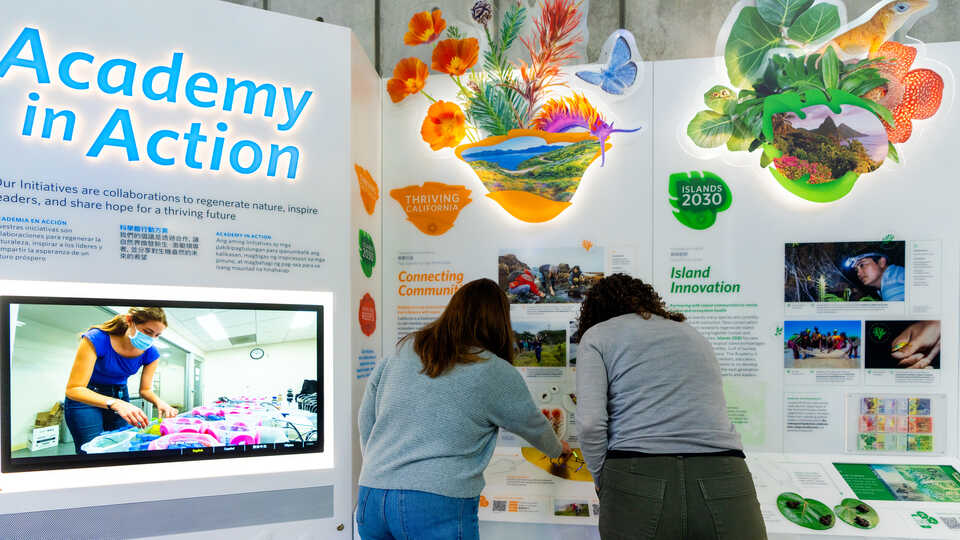The California Academy of Sciences is a renowned scientific and educational institution with a mission to regenerate the natural world through science, learning, and collaboration. Based in San Francisco’s Golden Gate Park, it is home to a world-class aquarium, planetarium, and natural history museum, as well as innovative programs in scientific research and environmental education—all under one living roof. Museum hours are 9:30 am – 5:00 pm Monday – Saturday, and 11:00 am – 5:00 pm on Sunday. Admission includes all exhibits, programs, and shows. For daily ticket prices, please visit www.calacademy.org or call (415) 379-8000 for more information.
Multimedia-rich kiosk spotlights biodiversity research and conservation across islands, coral reefs, and California

SAN FRANCISCO, CA (December 6, 2023) — The California Academy of Sciences is pleased to announce the opening of a new exhibition kiosk, Academy in Action, to showcase the research, conservation, and regeneration work being carried out by Academy scientists all over the world.
Inspired by the Academy’s regeneration initiatives, the exhibit uses video, images, and interactive elements to highlight the unique challenges and opportunities in each area and bring the three initiatives to life:
- Hope for Reefs: Despite covering less than 1% of the ocean floor, reefs support 25% of all marine life and the livelihoods of one billion humans. Hope for Reefs is a global project aimed at developing science-driven, community-based conservation solutions to reverse the decline of Earth’s coral reefs by the end of this decade.
- Islands 2030: Islands have among the highest concentrations of biodiversity on the planet, but are also epicenters of extinction, hosting 75% of all recent combined bird, reptile, amphibian, and mammal extinctions. Islands 2030 is developing novel, community-based conservation strategies at the ecosystem scale to slow and begin to reverse biodiversity loss across five major archipelagos by 2030 while supporting the United Nations Sustainable Development Goals.
- Thriving California: California’s wide variety of habitats, from coastlines to salt marshes and alpine peaks, support some of the world’s greatest diversity of plants and animals, many of which are severely threatened. Thriving California is regenerating biodiversity, building resilience to climate change, and advancing equitable access to nature in three major California ecosystems: forests, coasts, and cities—starting in San Francisco.
The California Academy of Sciences recently adopted a bold new mission and purpose: We regenerate the natural world through science, learning, and collaboration. "In addition to housing a world class planetarium, rainforest, aquarium, and natural history exhibits, the Academy cares for a vast natural history collection of 46 million objects that is used to inform our conservation efforts,” said Academy Executive Director Scott Sampson, PhD. “Academy staff work around the world to regenerate nature, collaborating with local communities to make ecosystems healthier and more resilient to threats like climate change. Academy in Action explores this impactful work, highlighting biodiversity as the thread that connects all we do. We’re excited to introduce museumgoers here in San Francisco to the regeneration projects being led by Academy scientists and community partners across the world.”
EXHIBIT FEATURES
An interactive video player with nine featurette films transports visitors to the stunning yet imperiled locations where Academy scientists and local partners are reimagining ecosystems for the future, from the rarified world of deep coral reefs to island biodiversity hotspots to our very own home state of California. Visitors will have the opportunity to hear from Academy scientists on the frontlines of the climate crisis, and learn about projects like the Xerces blue butterfly reintroduction in San Francisco’s Presidio, our Coral Regeneration Lab’s research into resilient corals to repopulate reefs of the future, and a STEM leadership cohort that brings island students and researchers to the Academy to receive world-class training on biodiversity science.
The exhibit also features interactive elements that allow guests to bring the initiatives to life through touch: Make cast bronze tree frogs sing to hear an unmistakable piece of an island soundscape right here in the museum, light up root systems of semi-parasitic plants to trace how these flora steal nutrients from their neighbors, and initiate a coral spawn as you learn about our strides in coral reproduction research.
Academy in Action also offers the opportunity for guests to learn about some of our fauna of focus—California butterflies, Madagascar chameleons, and coral reef parrotfish—and why regenerating these species and the ecosystems they depend on is critical to the healthy future of our whole planet.
MEDIA ASSETS:
- Photos of Academy in Action exhibit, credit Nicole Ravicchio © California Academy of Sciences
- Nine Academy in Action exhibit videos
- Islands 2030 video
- Hope for Reefs video
Press Contacts
If you are a journalist and would like to receive Academy press releases please contact press@calacademy.org.
Digital Assets
Hi-res and low-res image downloads are available for editorial use. Contact us at press@calacademy.org to request access.